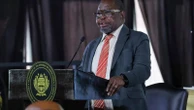Michelle Eisen, a 15-year Starbucks veteran, is a barista for the coffee chain at a location in Buffalo—the first Starbucks store to unionize back in December 2021, in fact. But on a Tuesday in March, Eisen was at a Pittsburgh Starbucks, to participate in what Starbucks Workers United members have dubbed “sip-ins.” A spin on “sit-ins,” they involve union workers and allies hanging out for hours in a Starbucks store, ordering drinks under names like “Union Strong” and leaving tips for workers.
In the weekend leading up to that Tuesday, union members held more than 100 sip-ins across the country. It was a message to Starbucks management: Union workers were calling attention to the fact that, more than three and a half years after organizing their first store, they still didn’t have a contract.
Negotiations between the union and the company have broken down, members say. Since September, the union has presented the company with a number of suggestions around wages, benefits, and guaranteed hours, all of which are meant to be negotiations, but it says the company wouldn’t even counter those offers. The union (and the National Labor Relations Board) argue that Starbucks hasn’t been bargaining in good faith.
But the Pittsburgh action was more than just a sip-in. Partway through, the workers at that store announced that they were on strike and walked out. Most of the attendees followed, forming a picket line on the sidewalk. Eisen and four others stayed in the store, refusing to leave. The sip-in had turned into an occupation.
The store’s manager called a manager from a different store for help. “They would periodically come over and they were like, ‘We need you to leave’ and we’d say, ‘We’re not leaving. We don’t know what you don’t understand about this, but we will sleep in the store,’” Eisen says. The five of them, all current or former Starbucks workers, were asking that company executives, including CEO Brian Niccol, talk to them and respond to the union’s demands.
The crowd outside grew louder; there were speeches and chants from people on the picket line. Eventually the store manager called the police, who gave the occupiers three warnings to exit the store. When Eisen and the others refused, they were arrested, handcuffed, and walked out the front doors.
That action was a form of civil disobedience, a nonviolent tactic in which people intentionally break the law or disobey orders in order to highlight actions they say are unjust. It has long been used by activists—during the civil rights movement, the fight for women’s suffrage, and frequently by labor unions looking to improve worker conditions.
For Starbucks Workers United, the decision to engage in acts of civil disobedience didn’t happen overnight. “It’s a natural evolution or escalation for where we are on the campaign,” Eisen says. “After three and a half years, still in bargaining, and . . . with an offer [from Starbucks] that is very far from sufficient given what this company can provide to its workers, we felt like we needed to take a stand.”
Starbucks sit-ins spur action
Starbucks Workers United has been doing various strikes since its inception in 2021, but recently, those protests and strikes have been escalating to arrests. A January sit-in at a Park Slope store was first. That was a union location that the company was permanently closing. Ahead of the closure, union members peacefully protested, and at least seven were arrested.
Those arrests got a lot of media coverage, and Eisen says it pushed the company to agree, in writing, that they were willing to go to mediation—a process in which a company and a union meet with a neutral third party mediator to assist in negotiations.
That agreement to use a mediator was the first progress the union has seen in weeks, Eisen says. Before that, there had been a December bargaining session at which the company proposed an economic package with no wage increases for union baristas. The union opposed that proposal, and then conducted a five-day strike across multiple cities.
The day of the Pittsburgh occupation coincided with two others, at a store in Chicago and also in Seattle. (In Chicago and Pittsburgh, 16 people in total were arrested.) The timing was intentional: The next day, March 12, Starbucks was holding a shareholder meeting. “We wanted them to go into that meeting having to defend their actions when it came to how they were dealing with the union stores [and] union workers,” Eisen says.
This week, we took direct action to show @Starbucks the urgency of finalizing contracts with the wages, staffing, and protections we need to thrive.We’re doing what it takes to win. And we won't stop until we do. pic.twitter.com/OQ60OOGUEO
At that meeting, Starbucks executives were asked when the company would negotiate its first union contract. Though she didn’t give a timeline, Sara Kelly, executive vice president and chief partner officer for Starbucks, answered in part that, “When a partner elects a union to represent them, we are committed to engaging in good faith with that union and the partners who have selected that union to negotiate fair contracts.”
In a response to a request for comment about these actions and the current bargaining process, a Starbucks spokesperson said the company is “focused on creating the best job in retail,” and added that the company and the union have held more than nine bargaining sessions since last April and three mediation sessions, reaching “over 30 meaningful agreements on hundreds of topics Workers United delegates told us were important to them.” They reiterated that the company is committed to good faith bargaining.
Why Starbucks workers say civil disobedience makes sense
Workers are willing to risk arrest to draw attention to their fight—and that fact alone should show the company how desperate its employees feel, the union says. “You’ve got people you employ who feel so strongly about the way you are mistreating them that they’re willing to put their body, their being, at risk to demand change,” Eisen says. “I just think you have to take that seriously.” The union and Starbucks have come to some tentative agreements—around issues like safety and dress code—but not on economic issues.
The union says the minimal concessions from the company—no raises in the first year and a guarantee of just 1.5% in future years—amounts to less than 50 cents an hour for most baristas. The union also still wants progress around guaranteed hours and staffing; they say some workers have had their hours cut below the threshold to qualify for benefits, even as stores are understaffed. Starbucks Workers United filed an unfair labor practice against the company specifically alleging that its refusal to negotiate on economic suggestions, instead coming with a “fixed economic position,” is against the spirit of bargaining in good faith.
Though Eisen was calmly walked out of the building when she was arrested, she says the sit-in was still nerve wracking: there are a lot of unknowns in terms of how the police will respond or how things may escalate. Though civil disobedience itself is nonviolent, it can provoke violent reactions from others.
The union knew that if they were going to engage in actions that come with safety risks or potential arrest, they had to prepare their members. Starbucks Workers United reached out to labor activist Bill Fletcher Jr. to run workshops on civil disobedience, mostly talking about the tactic’s history and what the union should know if it wanted to carry this out.
“The most important thing is that you have a critical mass of your membership that embraces this and feels the need for it,” he says, “because if you don’t, you will find yourself quickly isolated and ultimately defeated.”
When some people think of civil disobedience, they might think of the civil rights movement and the Greensboro sit-ins in which young Black students protested racial segregation. To some, the plight of Starbucks workers may seem, in comparison, less serious or not deserving of such drastic action. Unionized Starbucks workers have heard criticisms of their efforts since they began. When, in April 2022, an employee mentioned unfair labor practice charges against the company to then-CEO Howard Schulz, he told her, “If you’re not happy at Starbucks, you can go work for another company.”
Workers have also been criticized for being “just baristas,” implying that the title isn’t deserving of raises or worker protections. Baristas, though, have been trying to communicate just how chaotic and difficult their jobs are—and how understaffing exacerbates that. They’ve also highlighted issues with mobile ordering (asking for pauses or limitations during busy times) and their concerns about low pay.
Eisen adds that it’s a pervasive American viewpoint that some jobs are just bad, and people should try not to end up there. But there’s “very little recognition,” she notes, “of the fact that these are jobs that need to be done. And they are in a lot of ways essential. Why do we look at a job and say, ‘Well, that’s not a skilled job’?” Working at Starbucks has been the most physically demanding job she’s ever done—and she’s put in years to develop her skills, get to know regular customers, and make friends with coworkers. “Why should I walk away from all that?” she says. “Why not try to make it better?”
Starbucks union—and civil disobedience—sits in a bigger context
Diego Franco, a union member and Starbucks worker at a Chicago store, is trying to get a better job—by making his at Starbucks better. He was one of the people arrested at the Chicago sit-in, and though he said he felt nervous ahead of the action, it helped knowing he wasn’t doing it alone. “[Civil disobedience] comes with a lot of risk, but with that risk, it shows dedication—not just to get a contract, but to the people who you work with,” he says.
Starbucks workers all over the country are participating in a strong showing of solidarity today.Civil disobedience, strikes, solidarity actions, and more are happening at $SBUX locations all over the country.Hear us yet, @Starbucks? ITS TIME TO FINALIZE CONTRACTS NOW. https://t.co/e9GXWHFlFS pic.twitter.com/6hpxshl7l1
That camaraderie is key, Fletcher says. When speaking to the union, he emphasized the risks and hard realities of civil disobedience, how these actions require preparation—and the fact that workers need to know they’re not alone in order to get through it.
The Starbucks union’s cause has reached beyond the company. It helped spur a larger revitalized labor movement that has seen record-high strike actions and led to the highest U.S. support for labor unions since 1965. Starbucks workers sit in that broad labor context—as does civil disobedience as a tactic. “People are standing on the shoulders of others,” he says. “There’s a history to this.”
Since the first Starbucks store unionized in December 2021, it has been joined by more than 550 stores, encompassing more than 11,000 workers. Though labor experts have long said that penalties under current labor laws are so weak that they’re essentially toothless, the Trump administration has already been even more hostile toward unions, adding to the challenges workers face. Still, Eisen is hopeful about the future of Starbucks Workers United.
“I know these members and I know this campaign, and I know that for every one of us who gets exhausted and has to take a step back, there are 10 more Starbucks workers who are willing to step into their place. And so the company is fighting a losing battle,” she says. “We will keep growing [our actions] and getting bigger, until the company just has to recognize that.”








No comments